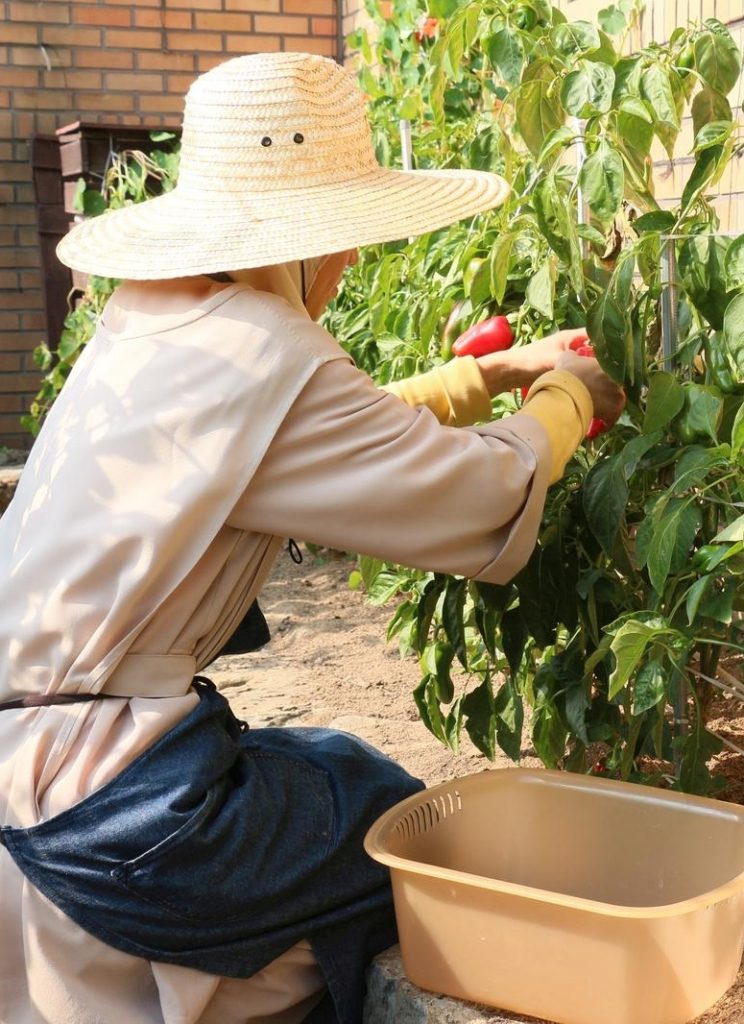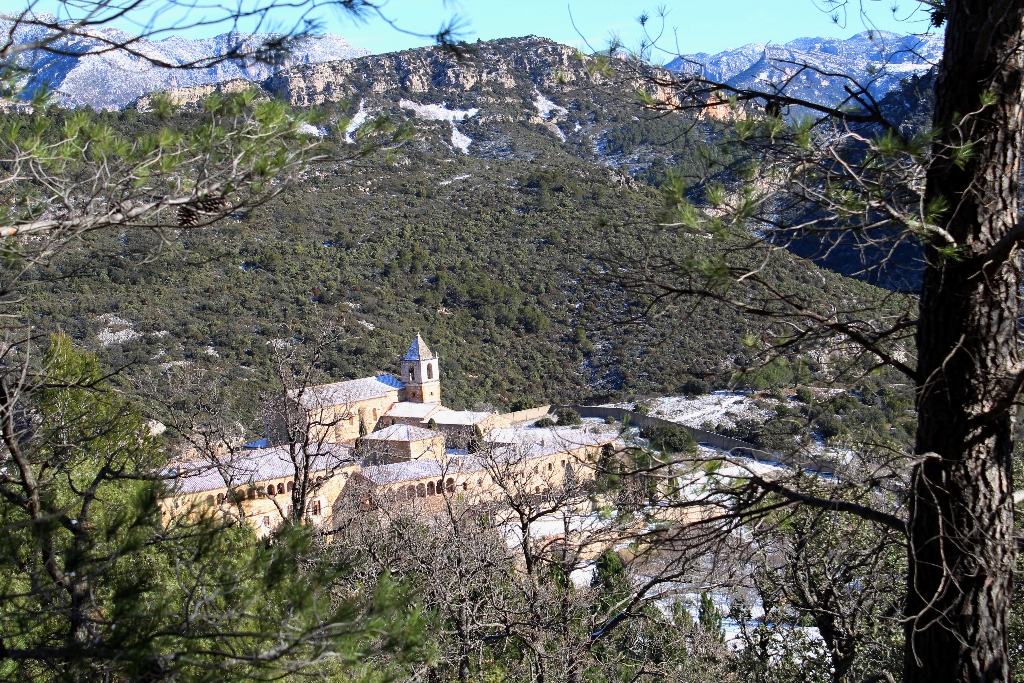
May our hearts be like a living altar from which a pure prayer rises to the Lord, and that it permeates all our actions.
(Statutes)
1. God’s Call
For nearly three thousand years, the Word of God has been alive and active: “I will seduce her, I will lead her to the desert and I will speak to her heart” (Hos 2,16). God attracts. God captivates. God wants to employ His overflowing love, God wants to “marry in fidelity, to make himself known” (Hos 2,21-22). And God leads to the desert. Solitude and stripping, aridity, thirst… but the desert also has its oases: God speaks and His Word springs up in joy!
The Carthusian nuns have left everything for Him. With Him, they live. In Him, they remain. Can God really demand that we live for Him alone? He does not demand it. Instead, He is waiting for it. Does He not deserve that a small number of those He created and redeemed should devote themselves to praising their Creator, glorifying their Saviour? Life in the Charterhouse has an absolute character: God alone, forever.
« It is not you who have chosen me, it is I who have chosen you and established you so that you may go, that you may bear fruit and that your fruit may remain” (Jn 15,16). The call is an initiative of God, who created every man to unite him with Him in an intimate love. The answer to this call is inscribed in the heart of all the baptized by the more or less hidden desire for union with God alone radiating in fraternal love. This desire is revealed more intensely in the one who wants to devote his whole life to the Lord.
The Carthusian vocation is the radicalization of the baptismal vocation, which the one who is called is invited to live without any intermediary. Our Father, St. Bruno, insists in his letter to his brothers in Chartreuse that it is a pure gift from God who grants it to whomever He wants, and that it is not just a matter of wanting it. Grace passes through the humble path of nature. Therefore, in addition to the love of solitude and our life, the candidate must have the physical and psychological abilities through which one can recognize the divine call, in other words, if advancing in the wake of Jesus in renunciation of herself, carrying her cross every day, she gradually blossoms in all dimensions of her person.
This discernment will take place throughout the time of ‘probation’ (i.e. during the long years that prepare her for the final commitment of the solemn profession) with, of course, special vigilance during the Postulancy and the Novitiate.

2. The Response
Seized by the love of Christ, the Carthusian nun gives herself to Him. She makes herself free, in the hope of loving Him totally and His family in the world. Loving as He has loved, and with His love. She has followed Jesus into the desert, but Jesus wants her to sink deeper and deeper into His way.
Have we ever finished leaving everything for Him? Have we ever finished looking for His face? God is the eternal fidelity of a perpetually new love. For a Carthusian nun, to love Him is to remain with Him alone and thus to commune with His fidelity. To love Him is to respond to His love, love always new in the joy of an unceasing walk with Him across the desert. The Carthusian desert can be the place of a beautiful adventure, more exciting than an expedition to the Sahara. The nun leaves, at the edge of the trail, everything that can hinder her and cut off her momentum towards the Lord. What matters to her is no longer what she wants, but what Christ wants.
What does He want? To make her His wife. For her, He wants a life totally devoted to Him in the hermitage of a charterhouse, with all its monotony and all its joy. The nun wants Him, too, and makes herself available to the Lord’s every wish.
Two Ways
The vocation of a Carthusian nun can be lived in one of two ways: as a nun of the cloister or as a converse nun. Both nuns live fully contemplative lives, both lives are completely oriented towards contemplation. But the two ways are a little different from each other.
The Nuns of the Cloister
The nuns of the cloister live in their hermitages most of the day, busy praying, studying, working. They are mainly responsible for the celebration of the common liturgy. They do various jobs in their cells: sewing, weaving, typing, carpentry, binding, icon painting, gardening, etc. Working in union with Jesus, in his poor and hidden life in Nazareth, is a contemplative work. The union with the Father’s will through works inspired by true obedience, for the good of the community, is the inexhaustible food for anyone who longs for God. Body and manual occupation can also facilitate a simple prayer, an almost incessant dialogue with the inner host. The most tiring tasks invite the nun to a deeper communion with the Passion of Christ, our Saviour.









The Converse Nuns
The converse nuns lead a life of authentic solitude and, in addition to prayer and study, use part of their day to work in the monastery outside their hermitages. Their main work is the service of the community, in the more practical field. For example, she would work in what is called an “obedience” rather than in her cell: it could be the kitchen, the laundry, the guest house, the infirmary, etc. The converse nuns, according to their assignments, devote themselves to multiple household tasks in the service of the community and the maintenance of the house. Although from time to time they have to help each other, most often they do their work in solitude. Normally the converse nun participates in the choir, in the church, in the same liturgical celebrations as the nuns of the cloister, but she can choose to sing or pray in silence. Their liturgical offices in solitude can be accomplished either with the Psalms or with reciting Paters and Aves.









The nuns of the cloister and the converse nuns share in complementary ways the responsibility of the mission of the Carthusian communities: to make exist within the Church a family of fully contemplative solitaries.
3. Stages of Formation
Formation

The young woman who comes to the monastery follows a path of initiation into a new life. Everything in it will have to be orientated towards contemplation. She goes to the school of St. Bruno so that her whole person, little by little, will become rooted in Christ, according to the call she received from God.
At the same time, formation tends to promote the integral development of one’s person, both in the human and spiritual fields. It is an inner adventure in the search for the true, the good, the beautiful.
The Itinerary Followed for Formation
A young woman who wishes to become a Carthusian nun will take the following steps:
Aspirant: The one who wishes to answer the Lord’s call according to the Carthusian charism is invited to make a short visit to meet us; then to perform a week’s retreat inside the monastery; and finally a one-month retreat, which is extendable, according to the availability of each one. The first year is thus a period of contact in order to know the life of the monastery and the sisters.
Postulant: The young woman puts on the “mantle” and lives inside the enclosure. For a year she is accompanied in the discernment of her vocation, while already living the common observances. The age limit for admission is 35 years old.
Noviciate: Lasts for two years. The applicant wears the Carthusian habit and is admitted into the communion of the Order. The “clothing” ceremony clearly expresses a deeper integration into the Carthusian family. The novice trains herself in the spiritual life, in the study of the liturgy and Carthusian observances. She learns to work in a state of recollection. She also began a cycle of studies to complete her doctrinal and monastic training.
First Vows: At the end of the novitiate, the candidate makes vows for three years. The profession is the free and conscious gift of her whole person to the Lord, out of love. The young professed woman wears a “cuculle” (or scapular) to which are added “bands” as a sign of her profession. This training stage is still under the guidance of the novice mistress. The mistress always accompanies her in the path of her human and spiritual formation. In the course of these three years, the young professed will deepen the spiritual and monastic formation begun at the novitiate.
Renewal of Vows: The profession is renewed for two more years. The young professed leaves the novitiate and “passes into community”, that is, she now lives with the nuns who have made their solemn profession of vows for a deeper mutual knowledge, thus fully experiencing the life she thinks she is embracing.
Solemn Profession: The solemn profession takes place at the end of these two years , which commits the person for their whole life. The nun is now one of the solemn professed, with her responsibilities and rights, thus definitively embracing the life to which she felt called.
After the solemn profession or perpetual donation, the nuns who wish to do so can receive the virginal consecration. This consecration follows a particular rite which includes not only the handing over by the bishop of the veil and the ring, outward signs of the indissoluble union with the Divine Bridegroom, but also the handing over of the stole. This confers on the consecrated nun some liturgical privileges, the most important of which is the proclamation of the Gospel on certain occasions. The Carthusian nuns have kept this rite as a concrete sign of the Lord’s call to the Carthusian Order to lead a life purely devoted to him.
After the solemn profession follows a Permanent Formation. Its purpose is to fuel the nun in her constant and ardent search for the Lord; it serves to help her not let go of zeal or to fall asleep on the way. The nun, constantly working towards a better knowledge of herself and the Lord, knows that putting on Christ is a work of transformation that spans all of her life. Permanent formation provides the salt and light that sustain the taste for God and guides her path to the final encounter.

4. Testimonies
A. From the World to the Charterhouse
«Why are we in the Charterhouse? With steps specific to each, we all followed the same path. We took the risk of giving up everything: family, friends, a profession, leisure, various commitments… Why?
We give thanks to God for a life we find pleasant. At the same time, we felt a thirst. Little by little, we discovered that prayer could soothe this thirst…
So it was for God that we were thirsty. We were looking for God and he was looking for us too. He wanted to meet us. He drew us to solitude and made us understand that this was our way to go to him. In silence we listened to Jesus in his Gospel: “For you when you pray, retreat to your room, close the door on yourself and pray to your Father who is there in secret, and your Father who sees in the secret will return to you” (Mt 6,6).
We have tried to unite our will with that of Jesus for us. He made us feel weakly what a meeting with him could be. “Remain in me as I remain in you” (Jn 15,4). He opened us more and more to his love… until the day we received from him the impulse to give him everything. Give it all to him? How?
His Providence made us aware of the existence of Carthusian nuns. The little we knew of it seemed to correspond to the desire for solitude put in us by the Lord. We asked to do a test of the life in their monastery. We were going to discover solitaries. Each lived in a small house, but their houses were connected by a cloister leading to the church. The meetings of the nuns were held mostly in the church. The share of community life was greater on Sundays and holidays.
« The Spirit drives Jesus into the desert” (Mk 1,12). The Spirit drives us to advance for a long time in the desert of a Charterhouse… and then stay there forever.
The desert: solitude, silence, peace and struggle, joy and aridity… everything can be a means to union with the Crucified-Resurrected Lord, when he gradually frees our hearts from what is not love. Our solitary life is also fraternal life: through Christ and in him, we are in communion with each other. This communion extends to the Church and to all our brethren in the world.».

B. The joy of singing for Him.
« No musical instrument is used during the Divine Liturgy in the Charterhouse, the singing is not accompanied. But to practice the songs in cell, a manual instrument is made available to the nun. While practicing in cell, I experienced pure joy in singing, a joy that filled my heart and that I could hear in my voice. During the visit of the Mistress of Novices, I was asked about my experience during singing practice and asked precisely if I had felt any joy. I was a little surprised by her question because I hadn’t told her about it, as I considered it a very personal and private matter between me and God, but she was interested because she saw it as a sign of what God’s call was for me in the community».












